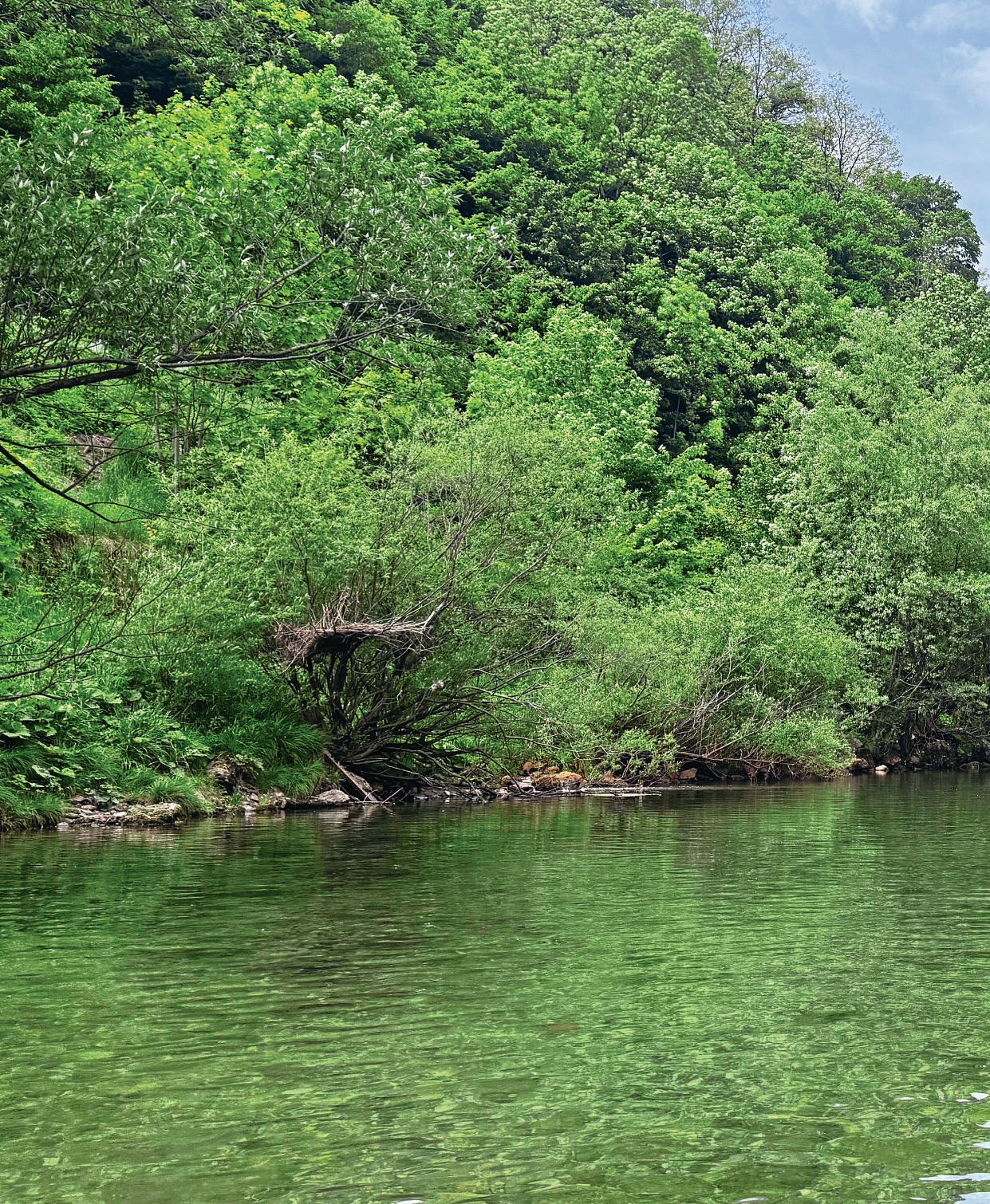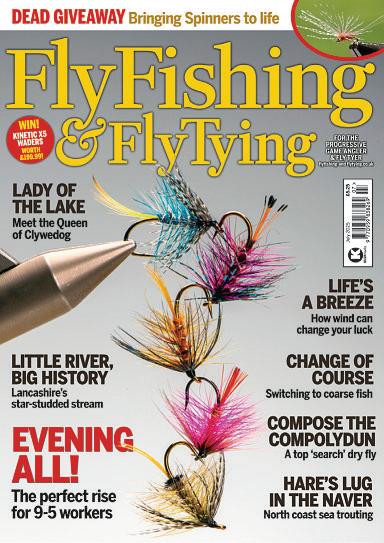
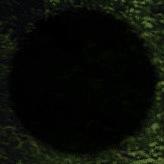


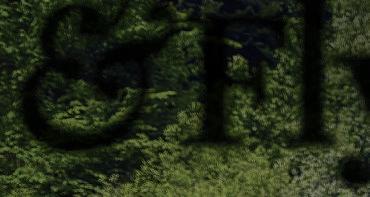



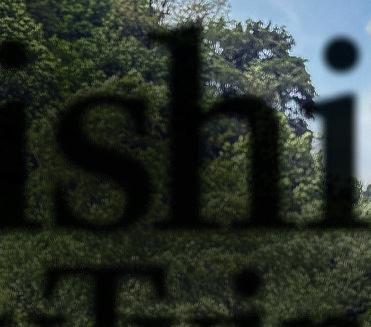
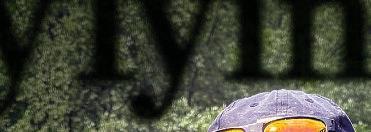
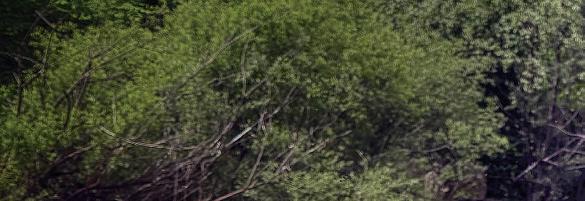


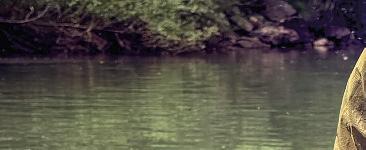


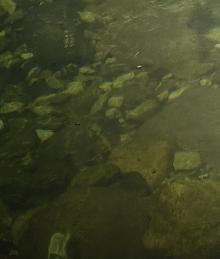













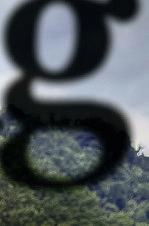

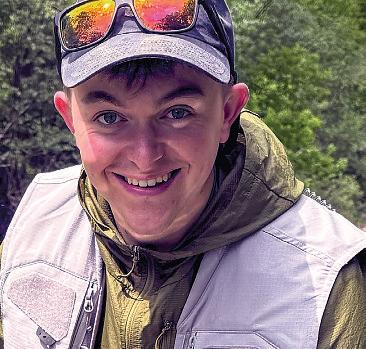
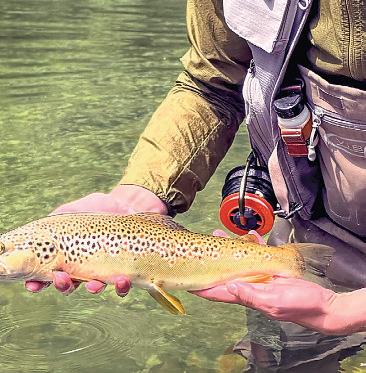
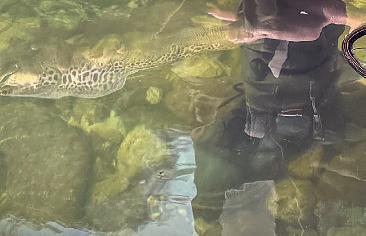
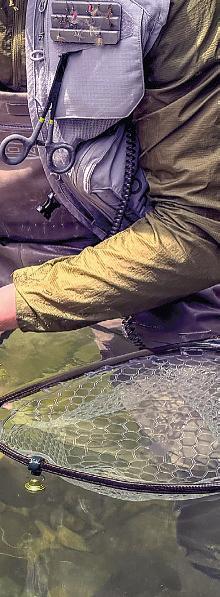


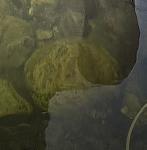



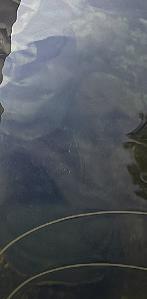


















































Like us on Facebook: Fly Fishing &Fly Tying Magazine
Publishing Editor Mark Bowler fffteditor@mortons.co.uk @FFFTMag
Publisher Oswin Grady Oswin Grady@kelsey.co.uk
Publishing Director DanSavage dsavage@mortons.co.uk
Newstrade and Subscriptions Manager Carl Smith csmith@mortons.co.uk
Head of Marketing CharlottePark Cpark@mortons.co.uk
ChiefReviewer Magnus Angus
Advertisement Sales Ian James Tel. +44 (0)7774282788 ian.fft@btinternet.com
Art Editor Kelvin Clements kclements@mortons.co.uk
Subscriptions and Enquiries
Media Centre, Morton Way, Horncastle,Lincolnshire, LN9 6JR
Customer services number: 01507529529
Telephone linesare open: Monday–Friday 8.30am –5pm
Distribution Seymour Distribution Ltd, 2East PoultryAvenue,London,EC1A9PT
ISSN: 0959-8383
Subscriptions (12 issues) from: UK £54; Europe £75; Rest of the world £80;
©Kelsey Media Ltd. All rights reserved. No part of this publication maybereproduced or transmitted in anyform or by anymeans, electronic or mechanical, including photocopying, recording, or any information storageretrievalsystem without prior permissioninwriting from the publisher
Printing
Acorn WebOfset Ltd, Normanton, West Yorkshire
Forall the latest fishing news, andblogs www.flyfishing-andflytying.co.uk
Visit page 20 for our best offers

Testing timesonthe Test:technical tipstocrack theMayfly hatch.


There’sstill aplace forthe traditionallyhackled dryflyinour modern game
IwaspleasedwhenMagnusAngus suggested featuring the Adams dryfly(p74),because it’s one of those patterns whichuses readilyavailable materials, requires alittle application and technical skill to tie it,and –bestofall –the resultant dressing is awonderful fly to fish.
Ageneral representationofupwingsinparticular –and olivesespecially– it’s aflywhichfloats well and is easytosee on the water surfacetoo.Hugelypopular in the States, this fly must have caught tens of thousands of trout during itslong life.For manyyears, it was responsible fortaking my biggest ever troutfrom the Tay,soI have asoftspotfor thedressing.
More poignantly, Ihave, this season, rekindled my faithintraditionallyhackled dryflies. Afew weeks ago, in desperation, Itied onto my tippet something very much akin toanAdams.I wascertain the fishwere takingolives, butmyarmoury of Emergers,Klinkhamers,parachutes and CdC styles were ignored steadfastly.Whentying it on, Irealisedthat
it must be years since I’dfished atraditionallytied dryfly, and Icastout with sometrepidation. Notfor long.The fly wasnailed within four feet of the first drift. Three more fishfollowed; everyone Icovered took it.Itcontinued to work afew days later,and then again in Slovenia, to proveitwas no flash in the pan. Thelesson I’ve learned is thatit’seasytof all into the trapofsolelyfishing in-the-film‘modern’dry fly styles, when sometimes the good old traditional collar-hackled fly will bringthem up with confidence.
Due to some upcoming changes with our credit card subscription paymentsystems, anumber of subscribers will be requested by Kelsey Publishing to update their scheduled paymentmethods in the coming months. We’rereallysorryfor the inconvenience thatthis will cause,but thank youinadvance for doing this –small titleslikeours relyonour loyal subscribers in order to keep bringing youthe best of fly fishing.Please stickwithus!
Threethingstodothis month

PAGE 34
INTERCEPTA GRILSE
Raining again? Makethe most of asummer spate

PAGE 36
SEEK ROMAN GOLD
TryNymphing forhard-fighting wild carp

PAGE 50
LOCH-STYLE ON DARTMOOR
Roaming free with the fly rod in clotted creamcountry
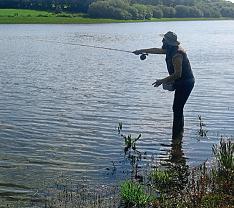






Magnus


Tying
Atool forconeheads and folding.

Does






THE POWER
Prof Eric McVicarthinks the 1950s scourge of salmon canstill redeem itself
50 LOCH-STYLE IN CLOTTED CREAM COUNTRY
DomGarnett
22 GHOSTS OF THE PAST
CharlesJardine re-visits some exquisitevenues and fliesoftimes longpast,and learnsnew lessons
34 SUMMER-GRILSE PROMISE
TomHarlandfishesonthe back of asummerspate with high hopes.
36 ROMAN GOLD
MikeHandyside sets out to landanelusive, wily,shy wild carp on fly,with the aid of acurious fly pattern.
42 SUMMER-TIME STRATEGIES
Shrunkenriver? Paul
Procter has 15 low-water tipstohelp us combat high-summerconditions




recommends mixing up bushytraditional patterns with imitativefliestoget the best from Dartmoor’s collection of reservoirs
60 HIDDEN GEM
30 SPOTLIGHT ON SPINNERS
PeterClark has developed anew technique to tie Spent Spinner patterns, which helpshim fish them intodusk.
55 TASTETHE DIFFERENCE BUZZER
DerekWebster reveals his Buzzer from Sainsburys
66 SURFACESURFER

Neil Pattersonsayseven the best Caddis patterns canbemade better



Nick Thomas says this post-industrial Welsh river valleynow harboursa diferent kind of gold.













Stunned in solitude. Nils Schraner took this shot after an hour'swalk above Loch Arkaig. The trout were rising justout of reach but the experience was'stunning'.
● Shoot a‘Shot of the Month’ and win a year’s subscription to FF&FT Send your phototo: fffteditor@mortons.co.uk

























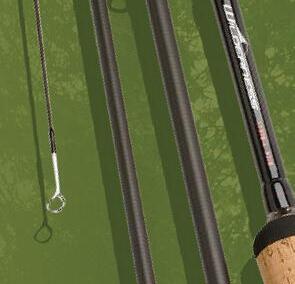
































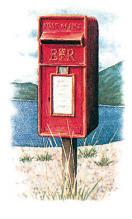
Write to: The Editor,FF&FT,The LocusCentre, TheSquare, Aberfeldy,PerthshirePH15 2DD,UK.
Email: ffteditor@mortons.co.uk. Please includeyourname andpostaladdress with all correspondence


Spinnersgather in the evening light.But whyare aquatic insect numbers dropping so fast?


Bringing back the eveningrise
The‘Letter of the Month’ (June 2025) waswell deserved, as it explains in layman’s terms just howphosphates andsilt in the water affects the blue-winged olive (b-wo).
Ihavefished since 1958, when my father took me to the reservo irs, dams, lakes andcanals around Shefeld and the rivers and canals of north Nottinghamshire. As Igrewolder,I often sat andwatched those fishing the fly on the riverWye at Bakewell and the riverDoveinDovedale and mar velled at the both the daytime and evening rises on those rivers and, because of my interest,the anglersthere often explained theflies tied to attempt to enticethe fish.
As wi th manyf is her men, school, collegeand my first job meantthatthere waslittle time forfishing, butwhenout hiking in the Peak District Iwould often sitand examinethe flies on the wing.In1976myjob wasmoved to the north eastwher e, now married, my wife and Ibought ahouse on the edgeofthe North Yorkshire Moors National Park It wasthislocation that encouraged me to buymyfirstflyrod to fishthe local reservoirs and the upper parts of the riverEsk as a club member.

The writer of the Letter of theMonth will receiveaspool of 13.7lb Seaguar Soft from Fordham &Wakefield.

Is rewilding re-writing the law?
Having been ar egula rv is itor to Sc otl and ’s ma gnificen tc oun tr ys id ef or many yea rs (m ore th an I ’d care to mention), Iamsaddened –and more than alittleconcerned –about what appears to be a growing trend to excludevisitorsfromparts of thecountry.
Iamreferringheremostly to t he in cr ea sed use of ou r wilderness areas for “rewilding”projects, where it appears aloophole hasbeen created, whichpreventspublic access to said givenareas.
Th ere are seve ral of these pr ojects und er way– and a gro wing nu mb er to follo w (whichaquick internet search can confi rm )a nd wh ils tI sy mp at hi se and ag ree wi th the principle of “rewilding” I fear this status is being abused, to simplystop people gaining ac ce ss to la rg ep ar ts of th e country.
Despite there being a‘Right to Roam’throughout Scotland, access to walking is restricted, whichisconcerning.However, there seems to be ag rowing t rend of refu sal of ac ces st o fish, and Ican nolonger visit some of the places Ihavefished and enjoyedfor many years. These places are very special to me, andI have many memories
of the times spen tf is hing , walking or simplysitting and relaxing with thesceneryand wildlifearound me,alongside like-minded peopleI have met along the way.
Wh ils ti tm ay se em a small amounto f“restricted /n oaccess” for countr ys ide pursuits (especiallyfor me as atrout angler)I am extremely worried at howf ar this will be permitted to go,and howmuch of ourbeautiful wild uplands will we willbedenied access to under the ‘rewilding’banner?
Ia ma ls oc oncerned, and al it tle su spicious, as to the reasoning behind all of this, and fear thatall might not be as it seems –o ri scla imed –wh en these projects are put into place.
Alongsidethis is the growing number of sporting estates being bought up by the very we al thya nd ,a lt ho ug hyou ca nsti ll ge ts om eacce ss fo r countrypursuits –primarily by hiring some form of accommodation –the costs of these arebecomingfrequentlymore prohibitive, duetoexpense for manypeople,and not justan aged pensioner such as I.
Idok nowt hatt here have al wa ys been “p res tigio us sporting places”throughout
allour sporting areas, but it se ems to be bec omi ng mor e fr eque nt th at la rget ract so f ground, over multiple estates (o ften neig hb ouring ), are under the ownershipofone, or as mall fe w, indiv iduals. This is resulting in the possibility that most of us are/will be ex clu de df rom en joyin g these places,simplythrough an ove r-expensive price-t ag for access.
As In ow have less ti me ahea do fm et han behind, I knowthatIwill have lots of options available to me for the time Ihaveleft, but also feel thatbecause of this, it would be too selfish of me not to air my concerns for all of those much younger,orindeed generations to follow,who couldbedenied the freedom and enjoymentI have experience dt hroug h my manytravels to our wild places.
So,a sI have no real id ea what else to do,Iwritethis to tr yand highlighttoall readers the dangers Ifeel we face becauseofa seeminglystealthy waywei ncr eas ing ly be ing denied access to the places and pursuits we love.
Dale Dillan, Leith, Edinburgh





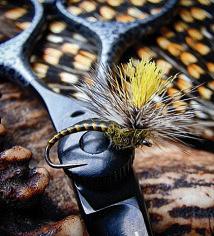




























In 198 5myj ob ch anged t o oneoffire-fightingqualityand developmentofprocess changes at all the companyplants in the UK.This gavemethe opportunity –onthe journey home! –to fishnumerous reservoirs, lakes and rivers, especiallyinsouthern Scotland, Cumbria and the north Pennines.
In 200 6, Iw as lu ck yt o gain membershipofPickering FisheryAssociation (PFA) but unfortunatelymostofthe fishings were damagedinthe floods of 2007.Onearly retirementin 2010,DaveSouthall (a contributor to this magazine), persuaded me to become invo lved in the RiverFly Monitoring scheme, arole Iperformed until 2023, when ill health forced me to quit.
In all these years of fishing the fly Ihaveseen amassive decline in not onlythe evening rise,but also the daytime rise.The first of note wasthe lossofthe great red sedgeonmylocal reservoirs, around 1994.Myobservations have sh ow nas ignificantl os s of mostflytypes in all waters, but mostworrying is the loss in waters not affected by sewage run-of,phosphate contamination,silt or roadwash.
So,w ha ti st he iss ue ?T he possible answerwas provided by afarmeronthe west coastofthe Shetland Mainland. In 2016, my wife and Ihad aholidaycottage, behindwhich were threelochs.
Afly line cracked at the loop still has plenty of lifeleftinit.
Ihaveatheory! Have you noticed welded loopsbecoming moreand morecommonon newfly lines?
It seems that anglerslikethe simplicityofhaving loops ready made on fly lines. Then, when a welded loop cracksline makers likethat anglersassume their line is broken and needs to be replaced. Nowthis is my theory, so ‘Big Fly Line’ has a salesfeaturewhich both sells their linesand which shortens the ‘life’ of afly line –it’sgreat marketing!
Damagetoa welded-loop is not terminal, neverterminal. No fly-line ever died when awelded
On an eveningideal fora massive midgerise there were no midges, and Iasked the farmer if he knew why.His answer wasfrightening. Midges drive the cattle and sheep mad,solikemanyhetreats the animals with veterinarypharmaceuticals. As they pass through the animal, these pharmaceuticals also then reduce the likelihood of disease carrying flies developing in the animal’s faeces.
Theonlymidgerise Iexperienced on thatholidaywas on the Isle of Unst,whilst attempting to fishthe sea trout run, where the midg es we re so thi ck it made seeing through themidge netdifcult –the midges won. Thereason for themidges was thatnopharmaceuticals were allowedhere –the stream and loch are abirdreserve.
Iamofthe opinionthatpharmaceuticals are contributing to the loss of our riverflies. There are several researchpapers on this topic thatare accessibleon theinternet,and agood place to start is on the Buglife website andthe paper: ‘Pharmaceuticals in freshwater environments and their potentialefects on freshwa ter inve rtebra tes’, He len Davison,Craig RMacadam and David Smi th; Septem ber 26, 2021
Ihope thatthis discussion and investigationprogressesfurther. Vince Ludlow, via email.

During the recent Reader Trip to Slovenia’srivers, editor Mark Bowler came across this ‘Flybrary’ –a noveland helpful idea, consisting of a framed foam panel pinned to atree, which contained an array of various fly patterns that had worked foranglers
on the river Unec,which were pinned intothe panel, ready forotherstouse,or, indeed could usefor reference.
The Flybraryworksona ‘Need one, takeone’,‘Have one,leave one’ basis It’sunclear if thereare fines issued foroverdue flies.
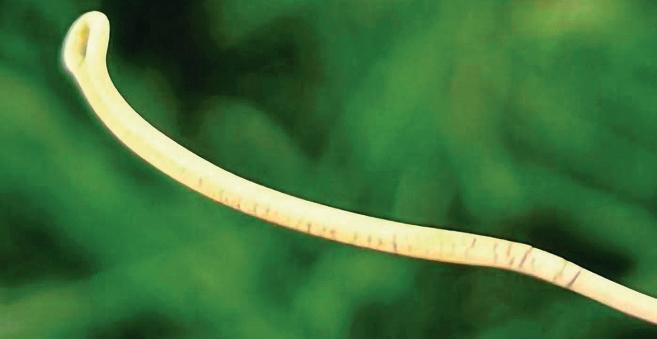
loop became damaged. We can snip off the loop and attach a braided loop,learn to tiea nailknot,experiment with shrink tube. thereare moreoptions,
or eo
but these arethe simplest.If the fly-line is fairly fresh, we canDIY re-weld thetip and discoverhow astonishingly simple it wastomakethat
The cracked tip of anew fly line.A beginner fly fisher tried casting without aleader and noticed the line made acracking noise.The loop is probably still fine,I’d go on using it until something worse happened. Then replace the loop, justthe loop
welded loop in the first place. Fly linesare consumable, and we will replacethem…but maybe not as oftenas‘Big fly Line’ likes us to believe



The lengthylegal fight to secure abetter futurefor North Yorkshire’s Costa Beckhas taken anew turnfollowinga furtherjudicial review.Fish Legal and Pickering Fishing Associationhad been highly critical of supposedlyrevamped measures by the EnvironmentAgency.Even after asecond victoryinthe courts, they fought for afreshjudicial review,stating that themeasures laid out would not solve existing issues or restorefish stocks
DEFRA it self has since conceded thate xisting plans
were illegal, unlawful andvague, following acourt hearing with major implications for rive rs across thecountry.The ruling raises critical questions about whether existingtargets comply with legalrequirements.
“Wewere gearing up to go into battle once again over the Costa Beck, so we are glad that the governmentseems to have ac ce pte dt hatith as fa il ed to properly implementthe lawin this case,after itshumiliating loss in the Court ofAppeal last month”, said Fish Legal solicitor,
Andrew Kelton
“Wha twen eed nowi sa complete changeinattitudeand effort from the Envi ro nment Agency on thebank. Thesiltand sewagepollution enteringthis riverhas to stop.”
Outgoing Fish Legal Head of Practice,PenelopeGane, added that:“If theCosta Beck andother rivers in theUKare to improve,it is essential thatwehavegovernments and environmental regulators that arewillingtoknuckle down and ge to nw it ht heir legalduties.”

Outgoing Fish LegalHead of Practice PennyGame: “itis essential that we have governments and environmental regulatorsthat arewilling to knuckle down and get on with their legal duties.”
Following ar ecord £104 million fine over environm ental brea ch es on sewagespills, anglers are calling for di rect re parations via the Water Re st oration Fu nd Bes id es the record fine over illegal disc har ge s, Th ames Water we re also pen alised an un preced en ted £1 8m illio n for breaking divid end ru les, furtherinfuriating anglersand conservationists.
Ang ling Tr us tH ea do f Cam paigns, St uart Si ng leton-White, described thepenalty as bringing “further shameona failing company” thathad “for too long go tawayw it hdelibera tel yp oll uting our wa ter

while handinghugedividends to itsparentcompanyand big bonuses to itssenior managers.”
It follows another alarming set of results from vo lu nt eer scientists
Monitoring Network(WQMN), wh ic hh as mo bi li sed re co rd nu mb ers of citizens to gathe r evidence and raise awareness across thecountry.After being launched as part of theAnglers AgainstPollution Campaign in 2022, theinitiativenow has775 tr ai ned vo lu nt ee rs on board , responsible for around 10,000 samples ac ross Engla nd an d Wales.
From July 2023 to July 2024, 45 %o fs am pl es ex ceed ed nitrate levels of concern, while 34%exceededthe thresholdfor phosphate pollution. Fu rther de tails on the in it ia tive an d currentfindingscan be found at anglingtrust.net
Echoing agrowing consensusamong conservation grou ps, inc lu ding the RSPB and Wi ldli fe Tr us ts, angling ch arities have wade d into the Planningand Infrastructure Bill
With criticsallegingthatover 5,000ofthe most sensitivesites in Englandalone couldbeput in jeopardy, the potential impact on rivers andfreshwater siteshave yettobeadequatelyexplored, saycampaigners.
“T he Pl anning and In frast ru cture Bill is an ag gre ssive at ta ck on na tu re,” sa i d Wi ldFishc ampaigner,Justin Neal. “Itthreatens the modern consensus on nature cons ervation in Englandand Wales andstrikes throughall thesafeguards we have for habitat and speciesprotection, in thename of growth.”
Ba ck ing su ch sen timen ts andthe risksposed by asystem

Conservation groupsare concerned the newbill forgrowthpaysinsufficient attention to habitatand species protection.
in wh ic hd ev elopers could payt os ide-step protections, th eA ng ling Tr us th as been
equallycritical.
“Some of the meas ures contained in the Planning and
Infrastr ucture Bill could pose at hreatt os ome of our most precious rivers and fishspecies as they will we aken the leg al protections and allowdevelopers to si mp ly payt ot rash na ture,” said Ang ling Tr us t He ad of Cam paigns, St uart SingletonWhite.
“Ina ny c ase the promised mi tiga tions coul dt aket en years to be realised and maybe in places farawayfrom where the original damage is do ne. Irreplaceable habitats, such as chalkstreams,and precious fish likesalmonand sea trout are threatened by this Bill.Eventhe gove rnment’sown watchdog, the Office for Environmental Protection, has said this Bill is “r egressive”a nd will we aken environmental protection.While economic growth is important, andweneedmorehousesbuilt, our rivers and fishdonot need to be sacrificedinthisway.”
NEWSTUDIE SINDICATE SERIOUSRISKS,AMID ST CLAIMS OF INADEQUATE LAWS AND LABELLING
Recentstudies have added ye tm ore ev id ence to the harm caused by pet pesticides and ingredientssuch as fipronil and im id acloprid , substancesbanned in UK agriculture,but still permitted in veterinary products.
Ro semar yP er kins of the Un iv ersi ty of Suss ex led a st udyt hatshowe dt hat, even after 28 days,levelsofharmful substances from ‘spot on’type pet treatments exceeded safe levels. Herteam found “astonishingly high levels”ofthe toxic ingredientsinUKrivers, while Perkins concludedemphatically: “Ifyour dogswims regularly, youshouldn’t be treatingitwith spot-on.”
With public awareness still low, howeve r, the st udya lso
warns thatregulators andthe industry should urgently change their guidelines and product labelling. More informationcan be found on the Ne wScientist website. Thefindingsobliterate flawedand dated paststudies. ThemostrecentEUresearchon the topic wasin2011, while pet industr ybackedstudies have been exposedfor flimsyscience, includingthe useofDaphnia in trials, aspecies showntohave high tolerancetoimidacloprid. Nordoesthe impact of toxic chemicalsbeginand end with rivers, and aseparate current independentstudyfrom China (Biomarkers reflecting thetoxicity of neonicotinoid insecticides t ot he cen tral ner vo us syst em , Yang andcolleagues, see Elsevier/sciencedirect.com)reveals
critical implications for human health. Com paring sam ples fromhealthyindividualsand those with neurologic disorders, researchers looked at the connection between levels of neurotoxic neonicotinoidpesticides (NEOs) and health problems. With most studiesfocussedonwildlifeand naturalorganisms,thisremains an under-explored area.
Theresearchstates thatNEOs not onlyhavethe potential to remainactive for long periods, but “can penetrate the bloodbrain barrier and remain in the CNS(central nervous system)” with severe potential impacts.
“Inhumans, NEO exposure might be associated with detrimental neurologicalconditions such as anencephalyand autism spectr um disorder ”states the

Dogs love water,but recent studiesof‘spot on’tick and flea applications administered on them areconcerning forboththe aquatic environment and also human health.
research,which studieda range of chemicals, several still used in UK petpesticides. Whilst stating thatfurther studies were needed, the report states that: “overall our data demonstrate thathighlevels of NEOs are observedinpatients with neurologic disorders”.























OWING £1.3 MILLION WELSH WATERFINE ,PRO SPECTIVE NEW LEGISLATION OFFERS RIVER CAMPAIGNERSFRE SH HOPE
ConservationistsinWales have been cheeredby the proposal of far-reaching legislation to better protect and restorethe country’sriversand countryside. Welshparliamentarian, HuwIrranca-Davies is the instigator of the newEnvironment(Principles, Government andBiodiversityTargets Wales) Bill.
Offering ab old bl ueprin t forchange, theSeneddCymru member is aiming to shakeup aflawe dsyste ma nd pu tt he environmentatthe heart of all newplanning and legislation.It would place policy makers and regulators under alegal obligation to prioritise biodiversity and su st ainability,c reating a newbody(TheOfce of Environmental Governance forWalesor OEGW)inthe process.

Thenew bill centres around four keyprinciples: prevention, precaution, rectification at source anda polluter pays approach. According to AfonyddCymru (AC), the charitable bodythat representsall sixWelsh river trusts, the bill could be a“long ov erd ue go ve rnance st ru cture”toput four environmental principles at theheart of law: “prevention, precaution,rectification at source and apolluter pays approach.“
Th is has been “b roa dl y we lco med”accordi ng to AC , although it adds that “concerns remain about the detail” –and in particular thatthe necessary “teeth”are there to back up real change”– nottomention building better regulation to fillthe gapsfollowing the UK’s postBrexit divorcefromEUlaw.
Nevertheless, the very prospect of the bill is hoped to be a “good indicator”inthe wake of We lshS enedd ele ctions next spring,which couldapply pressure to thevarious partiestoset outtheir environmental credentials. Thebill and supporting
documents can be found at the gov.waleswebsite
As fo rt he “p olluter pays ” concept, thiscould hardly be moretimelyafter WelshWater (DŵrCymr u) wasrecentlyhit wi th a£ 1,350,0 00 fine and ordered to payover£70,000 in costs, following ascathing verdict in thenationalcourts. Slammed for al acko fs elf-m onitori ng, We ls hWat er we re roundl y condemned for over800 sewage breaches in recentyears, pleadin gg ui lt yt o1 5o f18charge s levelled at them.
So extensive wasthe lack of data and testing,however,that Natural Resources Wales (NRW)
wasunable to accuratelyassess or respond to the total impact of negligence.
NRWHeado fO perations, Sian Wi lliams, wa ss tarki n her su mmar y, st at ing:“ Th is case highlight si nade qu ac ies in theprocessesatDŵrCymru whichled to widespread permit breaches across Wales and over the border during aperiod of twoyears. DŵrCymru’sperformancehas continued to decline for anumberofyears now, and this is astarkwarning to the companythatwewill not hesitate to use ourenforcementpowers to secure the improvements we expect to see.”
STUNNING 35-P OUNDER SEALS IT FOR VISITING LEARNER FROM NEWYORK
The RiverTweed’s Bemersy de Tr oph yf or the season’s bes tAtlan tic salmon is an awardthattends to be associated with ve te ran anglers; but the mostrecentprize hasbeenclaimedinspectacularstyle by arelativenewcomer. American visitor,MikeSmith hadcome to Scotlandwiththe aimoflearningtocasta doublehanded ro d– an do nj usth is second dayofpracticeonUpper No rth Wa rk ,h es tr uc kgold with an incredible35-pounder,
fis hi ng wi th hea db oa tm an , Martin Ritchie.
Meanwhile,the junior award wa sp rese nt ed to lo cal teenager and TweedStart rec ru it , MikeySmith (no relation!),for a cracking 25-pounder caught in Septemberlastyear.
“Today is awonderful opportunitytocelebratethe success of anglers—both local andinternational,’ said local MP,Joh n Lamont MP.“It’s areminder of just howvital theriver Tweedis to theBorders economy.”

PROF ERIC

Itisover30yearssince Ifirst wrote about the lostsalmon of the hy dro- rive rs. Ba ck then, Ih ig hlig ht ed both the diversion of water into neighbouring ca tc hmen ts an dt he effect of the Borland type fish lifts as being the major problems for migrating salmonids,and I receivedsevere criticism from the designer’s familyfor doing so
Today, Ibelieve it is timefor a rethink if we are to reverse the de cl ine in our salmon st ocks . Our once prolificand iconic fish is un de rs ever ep re ssur ea nd nowclassified as endangered.
So,whatcan we do?
There are manyissues that determine the number of salmon returning to our rivers. Some we, as either scientists,anglers or proprietors, can address, others we cannot.
Issues such as the fact thatthe salmon’s feeding grounds, for
the multi-sea-winter (MSW) fish of the Davis Straitand Baffin Baya reas we st of Greenla nd have move dn orth are totally out-with ourcontrol. However, the iss ue of the red uction in available nurseryareas dueto hydro-schemes, or the possibilityofasalmon gaining access to new–and previously inaccessible –spawning grounds are issues we can and, Ipersonally feel,shouldbefully investigated.
Lo oking ba ck, they say, is neveragood thing,but Ibelieve thati st otallyw rong;atl east when it comes to salmon spawning grounds.
Back in 1909 WilliamL eadbe tte rC al de rwood, am arine biologist and Fellowofthe Royal Society of Ed in bur gh wrote the firste dition of his cl assic work Salmon Rivers and Lochs of Scotland
Th es ec on de di ti on of th is

Despite the salmon’s ability to leap,they still can’t access manyofScotland’s primespawning streams,due to either poorly designed fish-passes, or falls that aresimplytoo high.

wo rk ,p ub lis hed in 19 21, not only givesdetails of therivers and lochs, but alsogives details, where he could access them, of catchreturns. It is from works su ch as this and others tha t we can ext ra ct the necessar y information from whichwecan establishjusthow manymiles of spawning streams and nursery areashavebeenlosttodevelopments such as hydro-schemes.
By comparing this to the likes of the 1985 mapbyRoss Gardiner and Ha rr yE gg lis hawo ft he Di str ibution in Sc ottish Rive rs of theAtlantic Salmon,(Scottish Fisheries Publication ISBN 0 903386 10 0),wecan also note thatithas not all been badnews.
Se ri ou sl yp ol lu te dw at er s back in early1900s, such as the riverClyde andits tributarythe
Ke lv in –w hic hwere bio logicallydeadin1920, but nowhave sustainablesalmon runs dueto thetremendous work of bodies likethe Clyde RiverPurification Board (1975-2016),and scientists likethe aforementioned Ross Gardiner.
Salmon are nowable to spawn we ll in to the Alland er Bu rn, wh ic hf lo ws do wn from the KilpatrickHills,and theGlazert Water,whichdrains from The Campsies, both flowing into the once toxic Kelvin before enteringthe Clydenexttothe GlasgowTra ns po rt Mu se um .O n the east sideofthe country, the riverCarron whichflowsinto the Forth, has also seen salmon returning to it so nce heavil y polluted waters. So,ithas not all been negative.
Unfortunately, the comparison of historic and currentworks reallydoeshighlight the negative
‘SPINELESS POLITICIANS WON’TSAVEOUR SALMON –BUT HYDROSCHEMES JUST MIGHT.’
impact of the rush to supplyelectricity to the Highlands which dates back to the 1950s.
So,c an we res tore the los t spawning grounds?
Ibelieve we can. Butonlyif the ScottishGovernmenthas the political will. (Those whoknow me well are only too aware that Ioften refertopoliticians,ofall hues, as resembling filleted fish –totallyspineless, and having no guts whatsoever.)
Ialso believe thatbymaking impassable falls passable,and at the same time generating clean, green electricity,wecould create largeareas of new, previously inaccessible,spawning grounds. This would also help counter the efects of climate change, as the higher up and further inland we can takeour spawning stock, the cooler the water will be
So howwouldthis work?
Having originallytrained as an engineer,and having worked on some ve ry large cons t ru ction projects, Iamwell aware

of the issues whichafect costs. One of these is thatofgetting he av yp lan ta nd eq ui pm en t onto remote sites, whether this is constr uction yards or even ofshore installations. So,ifwe were to install new‘runofthe rive r’ hydro-s ch em es ,p art of the consentwould betoensure that migratorystock are able to ascend freelytoany potential spawning groundsand juvenile habitat.
As all the necessaryplantand equipmentwoul db e‘on site’, thi swoul dr educe the costo f installing afish-pass fromwhat
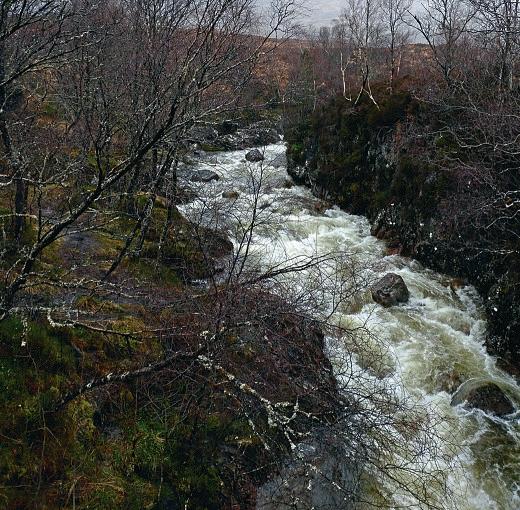
The currently insurmountablefalls wherethe Coupall joins the Etive. If a ‘run of theriver ‘hydro were installed it would be relatively simple,using modern rock-breaking equipment,toinstall afish-passalongside the pipe. This would open up anothertwo milesofexcellent juvenile habitat
it wo uld cos ti ft he pa ss wa s installed as aseparate project. It wouldalso create thepotential of vastly increasing the number of smolts produced in asystemif these newschemes were located directlyupstream of currently impassible falls.
Take,for example,the riverEtive Th is Argyllshire rive r, wh ich enters the seaatthe headofthe long,ford-likeLochEtive,has impassable fa lls roughlyf ive miles up from the top of the tide.A couple of milesfurther up st ream, ab ove these fa lls, the rive rl ev els ou ta nd has potentiallyexcellentspawning grounds andparr habitat.
Even as farback as 1921, WL Cald er wo od id en tified the potential of the water upstream to produceadditionalsmolts to the system. He also highlighted the input of the hatcher ysituated in thelower glen andthe man-made lochan into which the hatcherystockwere released. Thesuccess ofthis venture he also documents.
Back in Calder wo od’s tim e, heavy plantand rock-breaking equipmentasweknowitdid not exist. In those days,the late 19th and early 20th century, impassable falls were overcome using explosivesand human musclepower. Twoclassic examples of this type of engineering are seen on th er iver Mo ri st on ,whe re acha nnel, justupf rom Lo ch Ness, wascut throughrockto
from
enable fishtoreach miles of river upstream.
As ec on de xa mp le be in g wh ere the fa lls at the top of the Achate ny we re blasted to ena ble bot hs almon and sea trouttoaccess Loch Mudail in Ardnamurchan.
As one drive sn orth on the A82pastthe Kingshouse Hotel youcross overthe main headwater of the Etiveasitdrains west from the Moor of Rannoch It is clear,evenjustbydriving over the roadbridgeand looking both upstream anddownstream thatthis part of the riverwould be excellentparr habitat, being boulder-strewn andrife.
Further upstream are pockets of grave lb eds more than su it ab le for redds. Fu rther on, towards Glencoe,the Allt Coupall flows of the mountains betweenBuachailleEtive Mor an dBuach ai lle Et iveB eag. It flows eastward, paralleltothe A82before turning south to join themainstemofthe riverEtive less than half-a-mile down the Glen Etiveroad.
Fr om the A8 2a tA lltn afeadh one canlook down on the Coupall and see the excellent gravelbeds which, up until now, have neverbeenaccessibleto salmon.
Ju st ab ov ei ts conf lu ence with the Etive, the Coupall has impassable fa lls.Ift he pote ntial energy of these were to be harnessed and at the same time were made passable to fish, then the productivity of the Et ive would be greatlyenhanced.

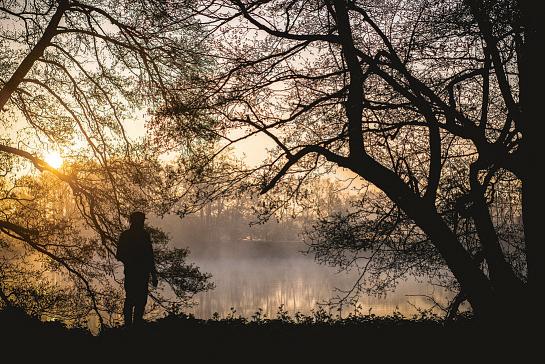















































































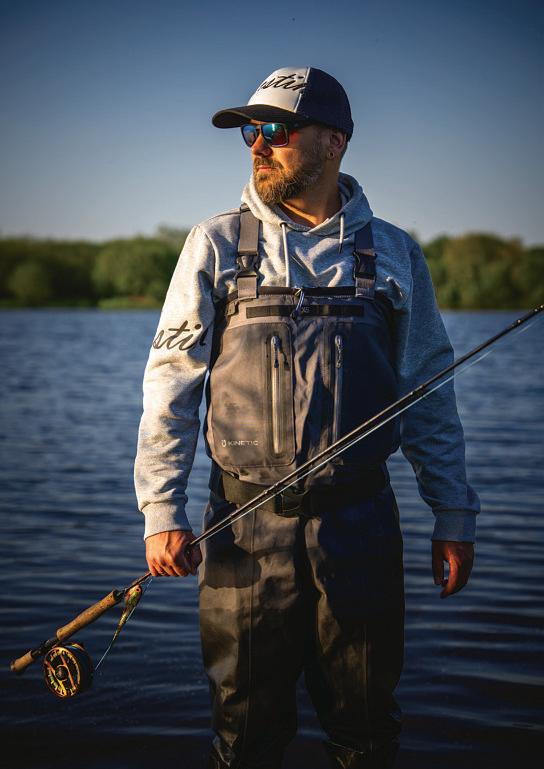







If both the upper Etiveand the Coupall were made accessible throughthe installation of ‘run of the river’ hydro-schemes and at one point, possibly,adam, it wouldinefect addten miles of additional spawning and juvenile habitat. This would treble the curren tp rod uction area avai lable to salmo n. No to nly that, but also it would providea bufer to climate change,asitis both further inland and higher up the syst em. In ad dition, it would also give an enhanced and local electricity supply.
Theonlyother obstacleisthatof bodies such as SNH and tourism operators, wholiketotake tourists to look at waterfalls. The former seem at timestoviewany change, other than that causedby nature,ornatural disasters, to be deemed undesirable.Obviously extinction of an ‘iconic’ (there’s thatword again!) species is preferable to the alteration o ft he river’s‘natural morpholog’.
As the utilisation of all renewable energy sources to combat climate changeisbecoming acritical issue,surelyprojects such as this must be worthyofconsideration?Upuntil recentyears,the government financed acommittee called the ‘Fisheries ElectricityCommittee’. This Committee oversawthe construction ofnew hydro-schemes. It wasoriginally appointed under the Electricity (Scotland) Ac t1 979 and wa s abolished under the Flood and Water ManagementAct of 2010 It is nowlefttothe Scottish Enviro nme nt Pr ote cti on Ag en cy (SEPA) to ensure thatany new sc hemes wo uld not be de trimental to ascentofmigrator y fish. But, as Ihavepreviously indicated, SEPAhavetorelyon the integrity of the applicants regarding whether or not salmon

and sea trout were presentabove anyproposed development, and the reliability ofsome environmentalimpactstudies has –and always will –bequestionable
We must,then, askourselves: “W ha ti sn eed ed to save our salmon?’”
My ow nf eeling so nt his matter are well known to many of both my angling friends and estate managers and gillies with whom Ihavehad the privilege to work with. What we need is aproper Salmon Environmental Task Force.Not acommittee thatmeets afew times ayearin agovernmentofce todiscuss,

Kingshouse looking toward Glencoe,perfect nurseryareas that could potentiallyhelp triplethe Etive’sproductivity.
The bottom of the gorgeonthe lowerEtivewould be ideal fora ‘mini hydroscheme’ which could bypass the ‘impassable’ falls, opening up another eightmilesofjuvenile habitat.
over cofee and biscuits, whether such-and-suchanestate’sapplication to install amini-hydro scheme is going to be detrimental to already declining and endangered salmon stocks.
This Task Force would only need to consistofhalf-a-dozen de dicated people to no to nl y ove rse ef uture deve lopments, but also to assess existing installations. Themembers of theTask Forcewouldbepractical, on-theground engineers and ecologists with in-depth knowledge of the salmon’s capabilities to ascend obstructions.
If these ins talla tions we re de emed uns ui ta ble or de trimental in anyway,recommendations for improvementwould be made and, if not implemented, then they would be enforceable by legal means. In thecase of large,long-established hydroschemes, such as thoseincorporating Borland passes, the group would work in conjunction with the owners to work out away to improve the situation.
Iwill emphasise at this point tha tS cottis ha nd Southern
Electricity,the currentowners of these lar ge uni ts, did not create the problems associated with their assets –they inherited them from the original owners the No rth of Scotland Hydro Electric Board.
Afurther responsibility of this Task Force couldbetoidentify potential projects th at coul d enable salmon to increase their range, whetherbyenvironmental improvements or by creating access in catchments, as with the riverEtive.
No do ub ts etting up aTask Fo rce liket hi swou ld require pressure to be put on politicians. What do youthink?
Pl ease let us know. If yo u agree,feel free to copy this articletoyour local MP or MSP (or should thatbefilleted fish?) ■
Eric McVicarstarted salmon fishingaged10, andhas over 50 years of experience on the Esks.Hewrotethe first salmonid/ ecolog management courses for theWestHighlandCollege UHI, and lectures internationally in Sustainable Ecolog.
